check engine CHRYSLER 200 CONVERTIBLE 2014 1.G Owner's Manual
[x] Cancel search | Manufacturer: CHRYSLER, Model Year: 2014, Model line: 200 CONVERTIBLE, Model: CHRYSLER 200 CONVERTIBLE 2014 1.GPages: 522, PDF Size: 3.09 MB
Page 444 of 522
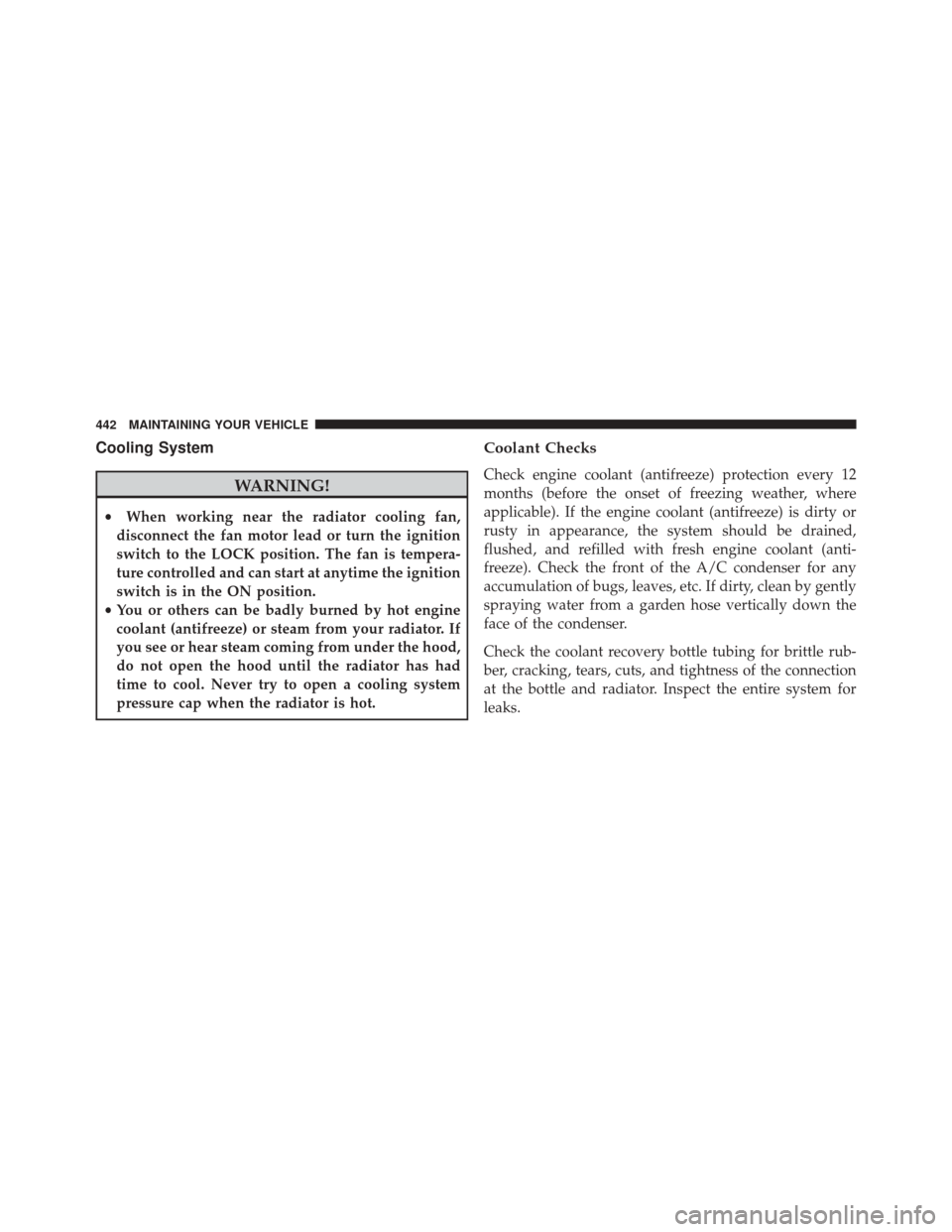
Cooling System
WARNING!
•When working near the radiator cooling fan,
disconnect the fan motor lead or turn the ignition
switch to the LOCK position. The fan is tempera-
ture controlled and can start at anytime the ignition
switch is in the ON position.
• You or others can be badly burned by hot engine
coolant (antifreeze) or steam from your radiator. If
you see or hear steam coming from under the hood,
do not open the hood until the radiator has had
time to cool. Never try to open a cooling system
pressure cap when the radiator is hot.
Coolant Checks
Check engine coolant (antifreeze) protection every 12
months (before the onset of freezing weather, where
applicable). If the engine coolant (antifreeze) is dirty or
rusty in appearance, the system should be drained,
flushed, and refilled with fresh engine coolant (anti-
freeze). Check the front of the A/C condenser for any
accumulation of bugs, leaves, etc. If dirty, clean by gently
spraying water from a garden hose vertically down the
face of the condenser.
Check the coolant recovery bottle tubing for brittle rub-
ber, cracking, tears, cuts, and tightness of the connection
at the bottle and radiator. Inspect the entire system for
leaks.
442 MAINTAINING YOUR VEHICLE
Page 448 of 522
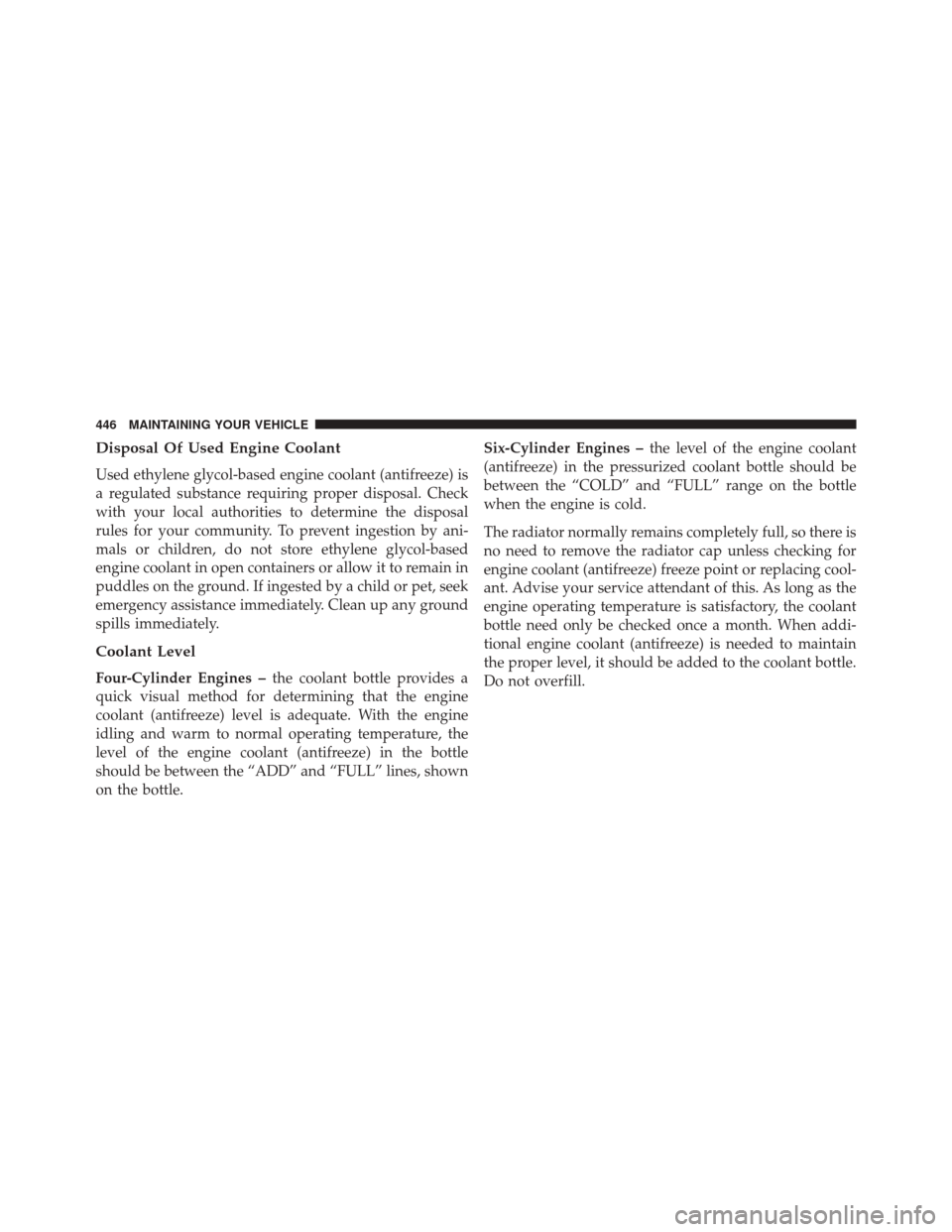
Disposal Of Used Engine Coolant
Used ethylene glycol-based engine coolant (antifreeze) is
a regulated substance requiring proper disposal. Check
with your local authorities to determine the disposal
rules for your community. To prevent ingestion by ani-
mals or children, do not store ethylene glycol-based
engine coolant in open containers or allow it to remain in
puddles on the ground. If ingested by a child or pet, seek
emergency assistance immediately. Clean up any ground
spills immediately.
Coolant Level
Four-Cylinder Engines –the coolant bottle provides a
quick visual method for determining that the engine
coolant (antifreeze) level is adequate. With the engine
idling and warm to normal operating temperature, the
level of the engine coolant (antifreeze) in the bottle
should be between the “ADD” and “FULL” lines, shown
on the bottle. Six-Cylinder Engines –
the level of the engine coolant
(antifreeze) in the pressurized coolant bottle should be
between the “COLD” and “FULL” range on the bottle
when the engine is cold.
The radiator normally remains completely full, so there is
no need to remove the radiator cap unless checking for
engine coolant (antifreeze) freeze point or replacing cool-
ant. Advise your service attendant of this. As long as the
engine operating temperature is satisfactory, the coolant
bottle need only be checked once a month. When addi-
tional engine coolant (antifreeze) is needed to maintain
the proper level, it should be added to the coolant bottle.
Do not overfill.
446 MAINTAINING YOUR VEHICLE
Page 449 of 522
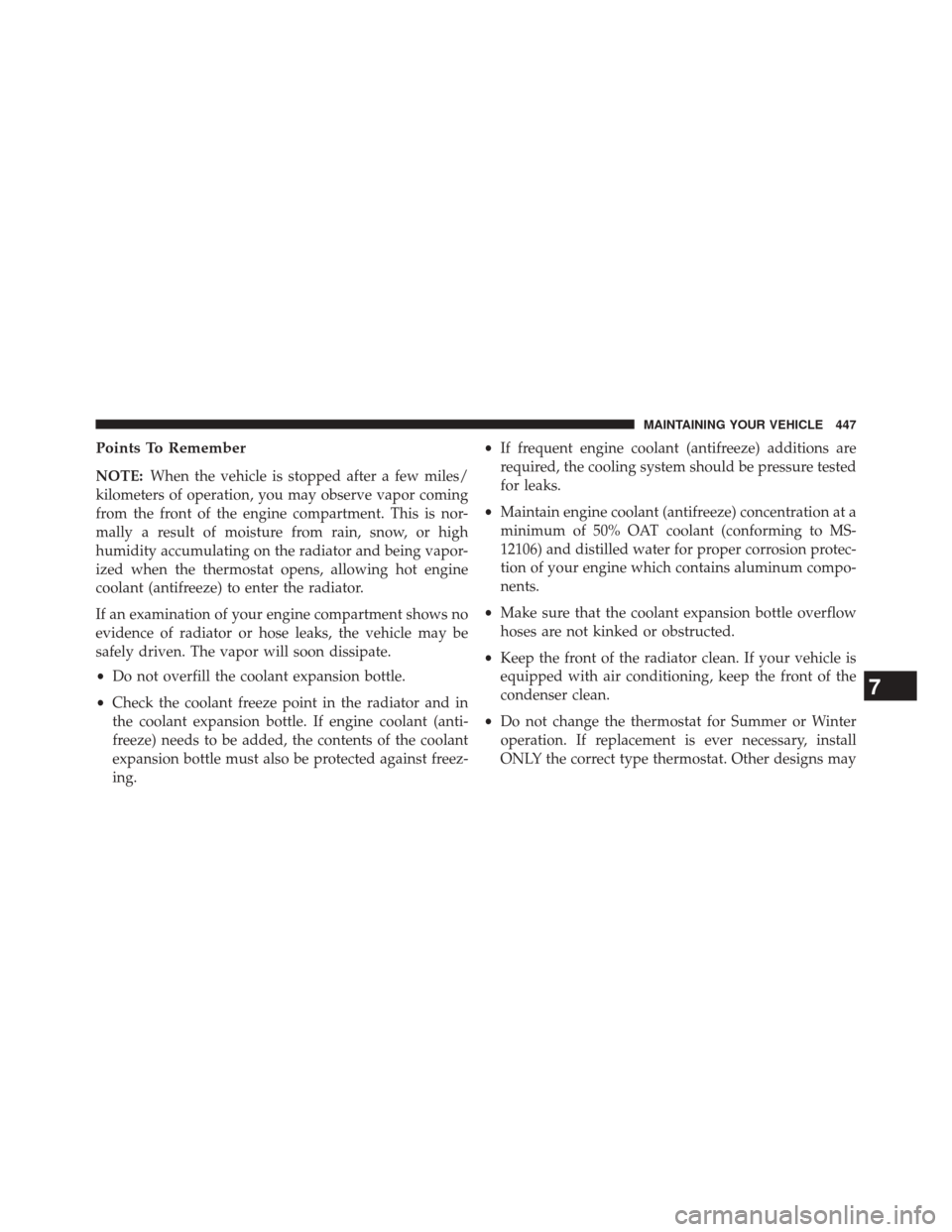
Points To Remember
NOTE:When the vehicle is stopped after a few miles/
kilometers of operation, you may observe vapor coming
from the front of the engine compartment. This is nor-
mally a result of moisture from rain, snow, or high
humidity accumulating on the radiator and being vapor-
ized when the thermostat opens, allowing hot engine
coolant (antifreeze) to enter the radiator.
If an examination of your engine compartment shows no
evidence of radiator or hose leaks, the vehicle may be
safely driven. The vapor will soon dissipate.
• Do not overfill the coolant expansion bottle.
• Check the coolant freeze point in the radiator and in
the coolant expansion bottle. If engine coolant (anti-
freeze) needs to be added, the contents of the coolant
expansion bottle must also be protected against freez-
ing. •
If frequent engine coolant (antifreeze) additions are
required, the cooling system should be pressure tested
for leaks.
• Maintain engine coolant (antifreeze) concentration at a
minimum of 50% OAT coolant (conforming to MS-
12106) and distilled water for proper corrosion protec-
tion of your engine which contains aluminum compo-
nents.
• Make sure that the coolant expansion bottle overflow
hoses are not kinked or obstructed.
• Keep the front of the radiator clean. If your vehicle is
equipped with air conditioning, keep the front of the
condenser clean.
• Do not change the thermostat for Summer or Winter
operation. If replacement is ever necessary, install
ONLY the correct type thermostat. Other designs may
7
MAINTAINING YOUR VEHICLE 447
Page 450 of 522
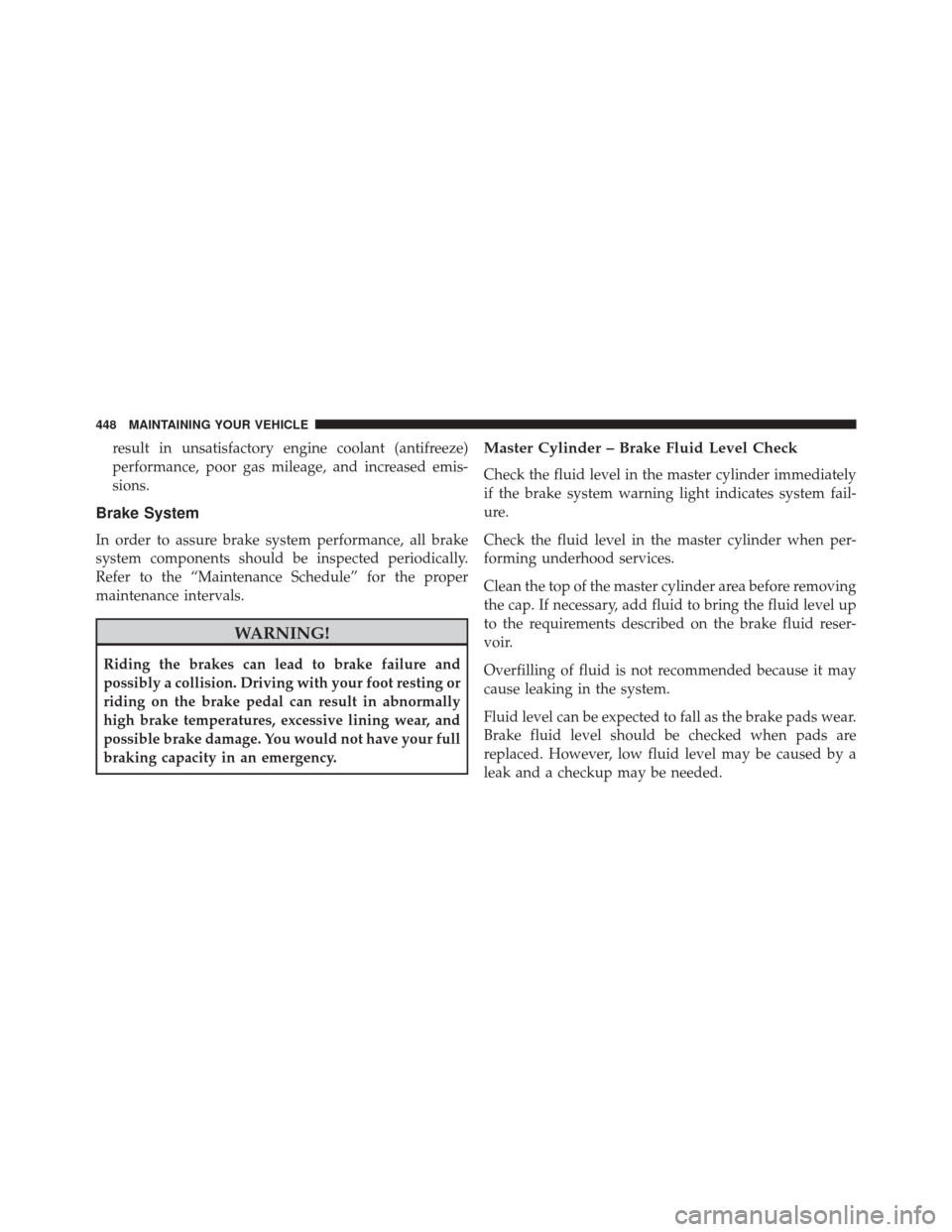
result in unsatisfactory engine coolant (antifreeze)
performance, poor gas mileage, and increased emis-
sions.
Brake System
In order to assure brake system performance, all brake
system components should be inspected periodically.
Refer to the “Maintenance Schedule” for the proper
maintenance intervals.
WARNING!
Riding the brakes can lead to brake failure and
possibly a collision. Driving with your foot resting or
riding on the brake pedal can result in abnormally
high brake temperatures, excessive lining wear, and
possible brake damage. You would not have your full
braking capacity in an emergency.
Master Cylinder – Brake Fluid Level Check
Check the fluid level in the master cylinder immediately
if the brake system warning light indicates system fail-
ure.
Check the fluid level in the master cylinder when per-
forming underhood services.
Clean the top of the master cylinder area before removing
the cap. If necessary, add fluid to bring the fluid level up
to the requirements described on the brake fluid reser-
voir.
Overfilling of fluid is not recommended because it may
cause leaking in the system.
Fluid level can be expected to fall as the brake pads wear.
Brake fluid level should be checked when pads are
replaced. However, low fluid level may be caused by a
leak and a checkup may be needed.
448 MAINTAINING YOUR VEHICLE
Page 453 of 522
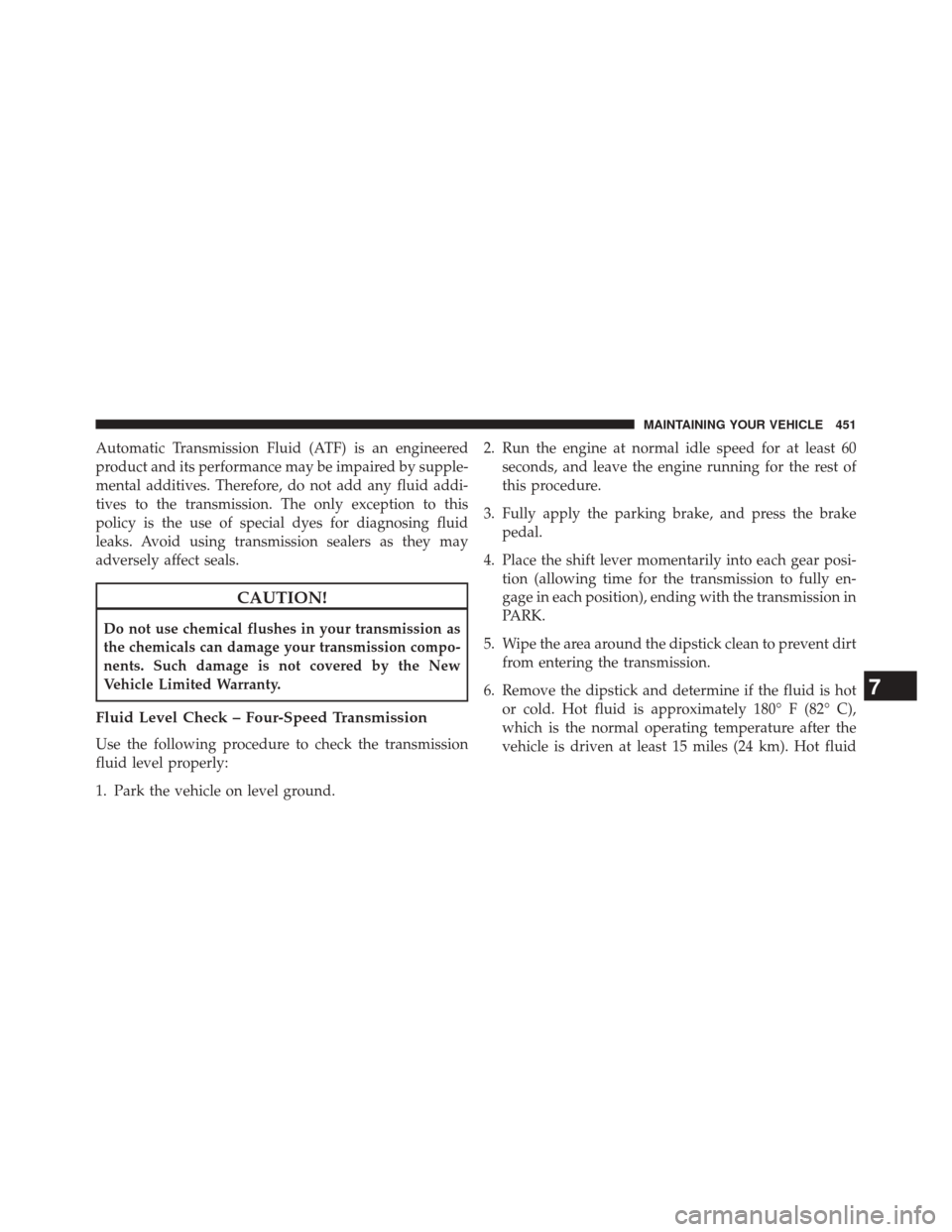
Automatic Transmission Fluid (ATF) is an engineered
product and its performance may be impaired by supple-
mental additives. Therefore, do not add any fluid addi-
tives to the transmission. The only exception to this
policy is the use of special dyes for diagnosing fluid
leaks. Avoid using transmission sealers as they may
adversely affect seals.
CAUTION!
Do not use chemical flushes in your transmission as
the chemicals can damage your transmission compo-
nents. Such damage is not covered by the New
Vehicle Limited Warranty.
Fluid Level Check – Four-Speed Transmission
Use the following procedure to check the transmission
fluid level properly:
1. Park the vehicle on level ground.2. Run the engine at normal idle speed for at least 60
seconds, and leave the engine running for the rest of
this procedure.
3. Fully apply the parking brake, and press the brake pedal.
4. Place the shift lever momentarily into each gear posi- tion (allowing time for the transmission to fully en-
gage in each position), ending with the transmission in
PARK.
5. Wipe the area around the dipstick clean to prevent dirt from entering the transmission.
6. Remove the dipstick and determine if the fluid is hot or cold. Hot fluid is approximately 180° F (82° C),
which is the normal operating temperature after the
vehicle is driven at least 15 miles (24 km). Hot fluid
7
MAINTAINING YOUR VEHICLE 451
Page 484 of 522
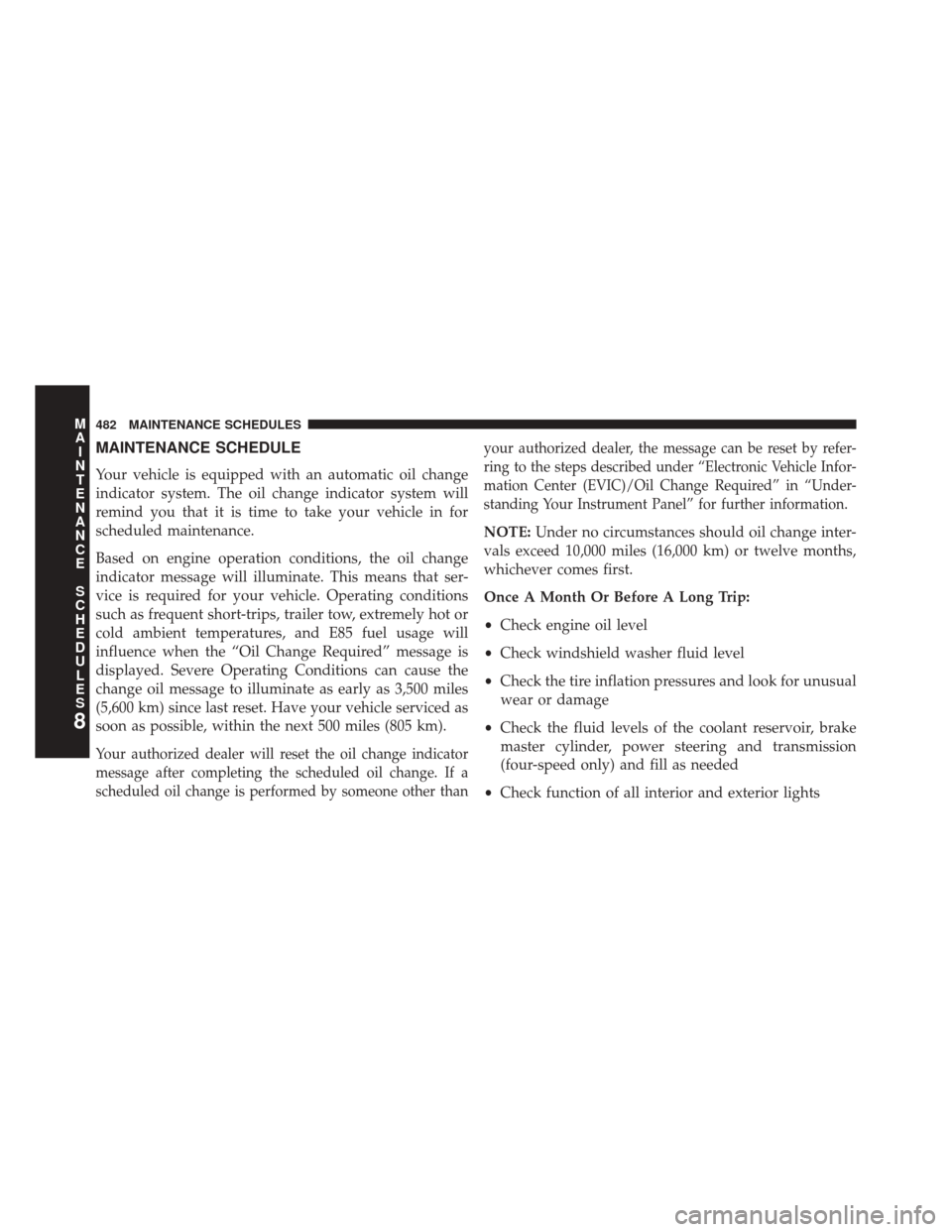
MAINTENANCE SCHEDULE
Your vehicle is equipped with an automatic oil change
indicator system. The oil change indicator system will
remind you that it is time to take your vehicle in for
scheduled maintenance.
Based on engine operation conditions, the oil change
indicator message will illuminate. This means that ser-
vice is required for your vehicle. Operating conditions
such as frequent short-trips, trailer tow, extremely hot or
cold ambient temperatures, and E85 fuel usage will
influence when the “Oil Change Required” message is
displayed. Severe Operating Conditions can cause the
change oil message to illuminate as early as 3,500 miles
(5,600 km) since last reset. Have your vehicle serviced as
soon as possible, within the next 500 miles (805 km).
Your authorized dealer will reset the oil change indicator
message after completing the scheduled oil change. If a
scheduled oil change is performed by someone other thanyour authorized dealer, the message can be reset by refer-
ring to the steps described under “Electronic Vehicle Infor-
mation Center (EVIC)/Oil Change Required” in “Under-
standing Your Instrument Panel” for further information.
NOTE:
Under no circumstances should oil change inter-
vals exceed 10,000 miles (16,000 km) or twelve months,
whichever comes first.
Once A Month Or Before A Long Trip:
• Check engine oil level
• Check windshield washer fluid level
• Check the tire inflation pressures and look for unusual
wear or damage
• Check the fluid levels of the coolant reservoir, brake
master cylinder, power steering and transmission
(four-speed only) and fill as needed
• Check function of all interior and exterior lights
8
M
A I
N T
E
N
A
N
C E
S
C
H E
D
U L
E
S482 MAINTENANCE SCHEDULES
Page 503 of 522
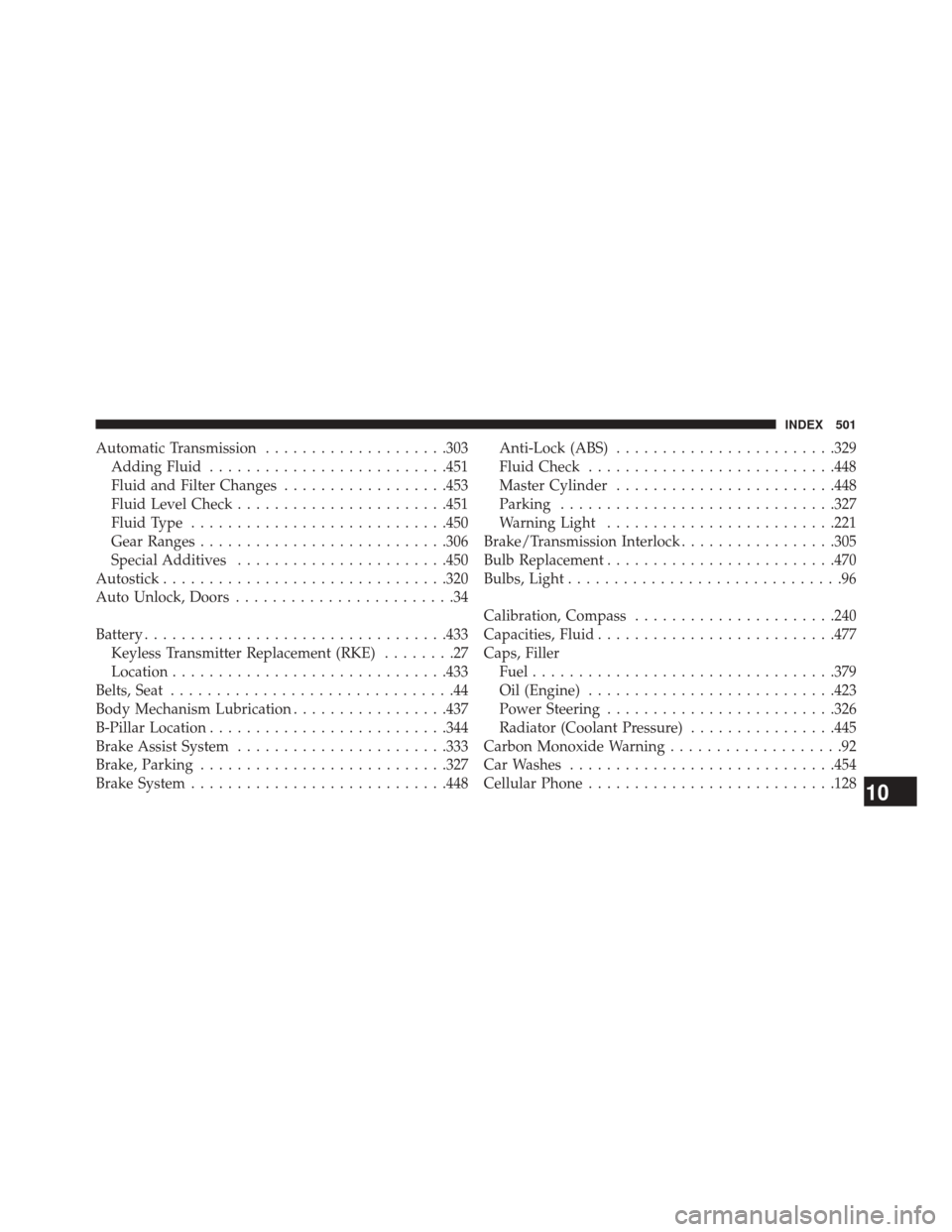
Automatic Transmission....................303
Adding Fluid ......................... .451
Fluid and Filter Changes ..................453
Fluid Level Check ...................... .451
Fluid Type ........................... .450
Gear Ranges .......................... .306
Special Additives ...................... .450
Autostick .............................. .320
Auto Unlock, Doors ........................34
Battery ................................ .433
Keyless Transmitter Replacement (RKE) ........27
Location ............................. .433
Belts, Seat ...............................44
Body Mechanism Lubrication .................437
B-Pillar Location ......................... .344
Brake Assist System ...................... .333
Brake, Parking .......................... .327
Brake System ........................... .448Anti-Lock (ABS)
....................... .329
Fluid Check .......................... .448
Master Cylinder ....................... .448
Parking ............................. .327
Warning Light ........................ .221
Brake/Transmission Interlock .................305
Bulb Replacement ........................ .470
Bulbs, Light ..............................96
Calibration, Compass ..................... .240
Capacities, Fluid ......................... .477
Caps, Filler Fuel ................................ .379
Oil (Engine) .......................... .423
Power Steering ........................ .326
Radiator (Coolant Pressure) ................445
Carbon Monoxide Warning ...................92
Car Washes ............................ .454
Cellular Phone .......................... .128
10
INDEX 501
Page 504 of 522
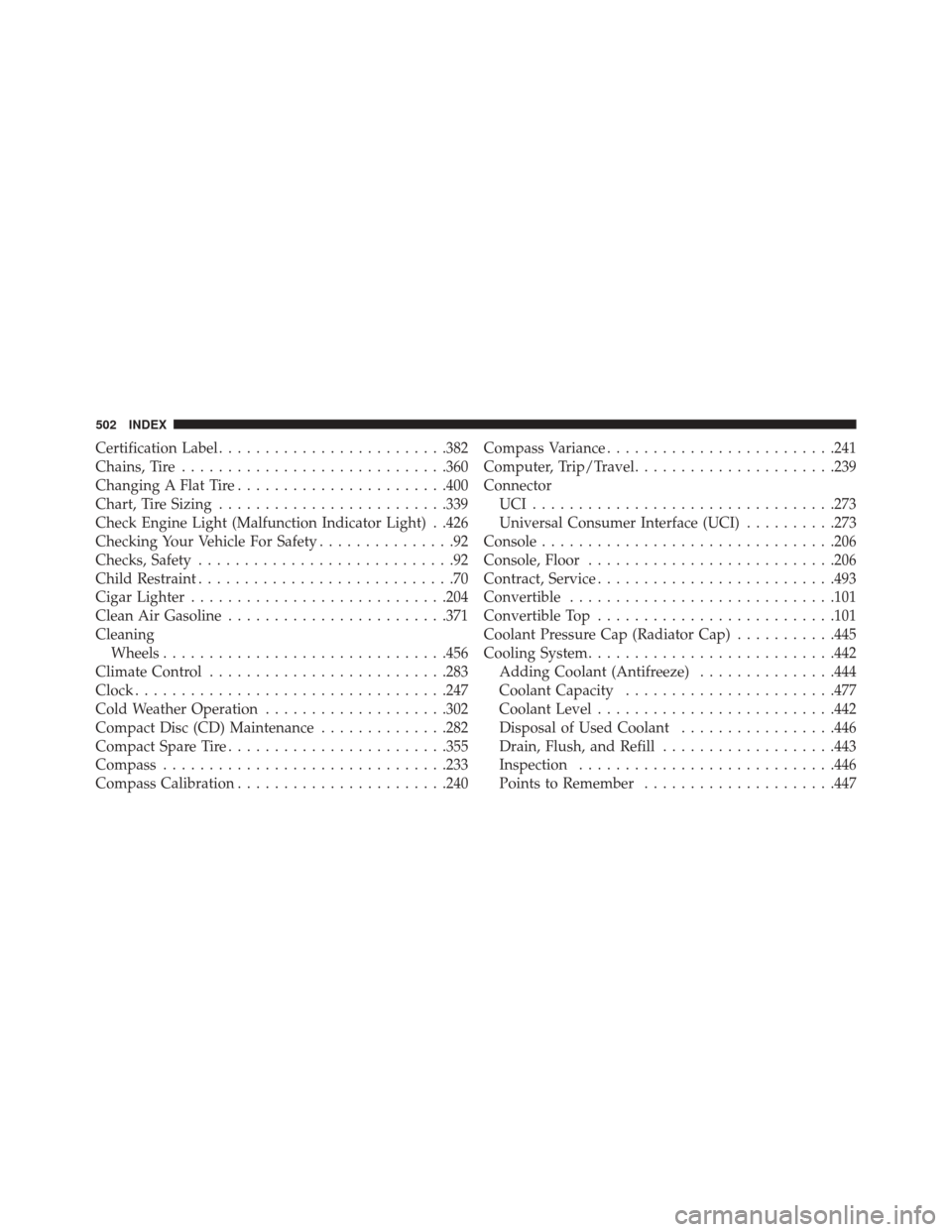
Certification Label........................ .382
Chains, Tire ............................ .360
Changing A Flat Tire ...................... .400
Chart, Tire Sizing ........................ .339
Check Engine Light (Malfunction Indicator Light) . .426
Checking Your Vehicle For Safety ...............92
Checks, Safety ............................92
Child Restraint ............................70
Cigar Lighter ........................... .204
Clean Air Gasoline ....................... .371
Cleaning Wheels .............................. .456
Climate Control ......................... .283
Clock ................................. .247
Cold Weather Operation ....................302
Compact Disc (CD) Maintenance ..............282
Compact Spare Tire ....................... .355
Compass .............................. .233
Compass Calibration ...................... .240Compass Variance
........................ .241
Computer, Trip/Travel ..................... .239
Connector UCI................................ .273
Universal Consumer Interface (UCI) ..........273
Console ............................... .206
Console, Floor .......................... .206
Contract, Service ......................... .493
Convertible ............................ .101
Convertible Top ......................... .101
Coolant Pressure Cap (Radiator Cap) ...........445
Cooling System .......................... .442
Adding Coolant (Antifreeze) ...............444
Coolant Capacity ...................... .477
Coolant Level ......................... .442
Disposal of Used Coolant .................446
Drain, Flush, and Refill ...................443
Inspection ........................... .446
Points to Remember .....................447
502 INDEX
Page 506 of 522
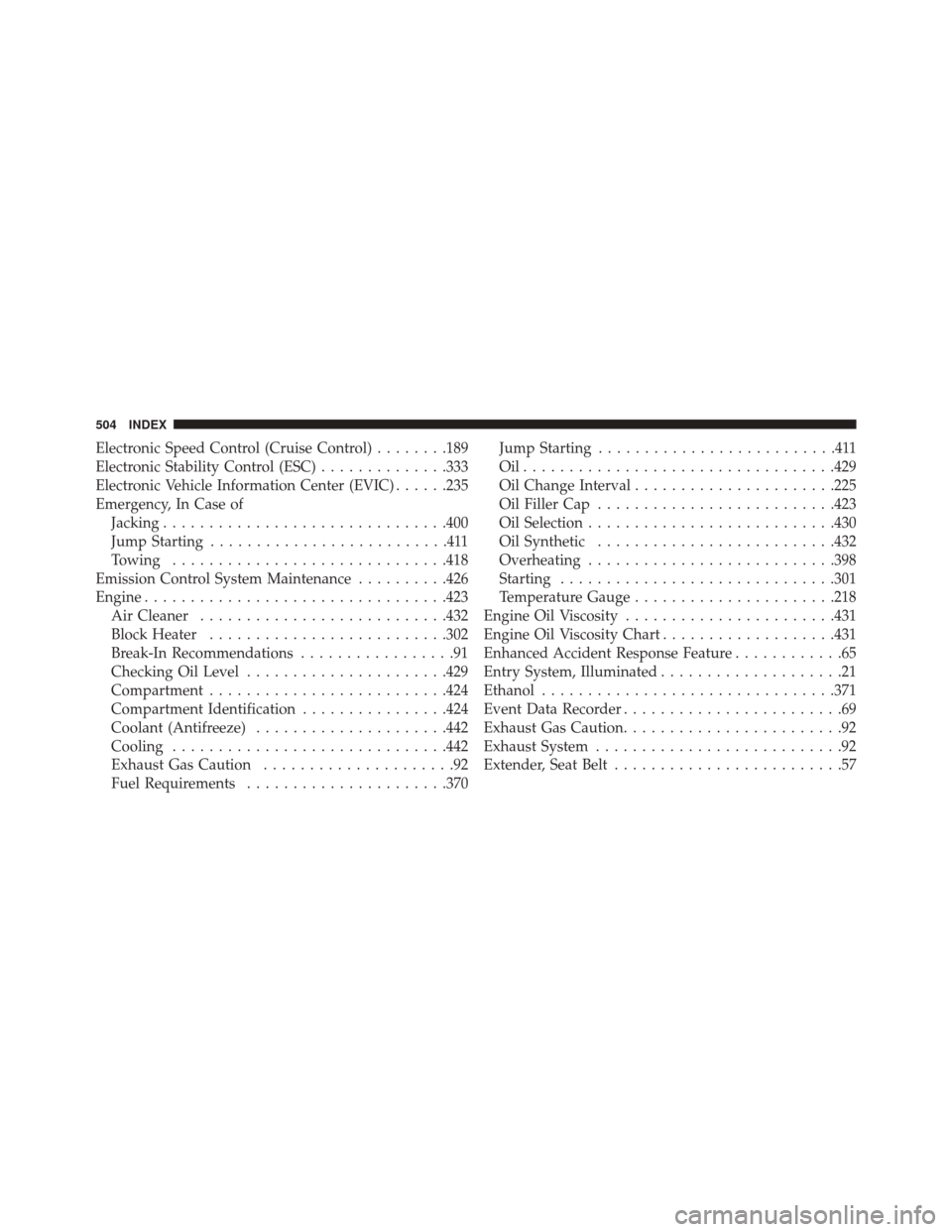
Electronic Speed Control (Cruise Control)........189
Electronic Stability Control (ESC) ..............333
Electronic Vehicle Information Center (EVIC) ......235
Emergency, In Case of Jacking .............................. .400
Jump Starting ..........................411
Towing ............................. .418
Emission Control System Maintenance ..........426
Engine ................................ .423
Air Cleaner .......................... .432
Block Heater ......................... .302
Break-In Recommendations .................91
Checking Oil Level ..................... .429
Compartment ......................... .424
Compartment Identification ................424
Coolant (Antifreeze) .....................442
Cooling ............................. .442
Exhaust Gas Caution .....................92
Fuel Requirements ..................... .370Jump Starting
..........................411
Oil................................. .429
Oil Change Interval ..................... .225
Oil Filler Cap ......................... .423
Oil Selection .......................... .430
Oil Synthetic ......................... .432
Overheating .......................... .398
Starting ............................. .301
Temperature Gauge ..................... .218
Engine Oil Viscosity ...................... .431
Engine Oil Viscosity Chart ...................431
Enhanced Accident Response Feature ............65
Entry System, Illuminated ....................21
Ethanol ............................... .371
Event Data Recorder ........................69
Exhaust Gas Caution ........................92
Exhaust System ...........................92
Extender, Seat Belt .........................57
504 INDEX
Page 507 of 522
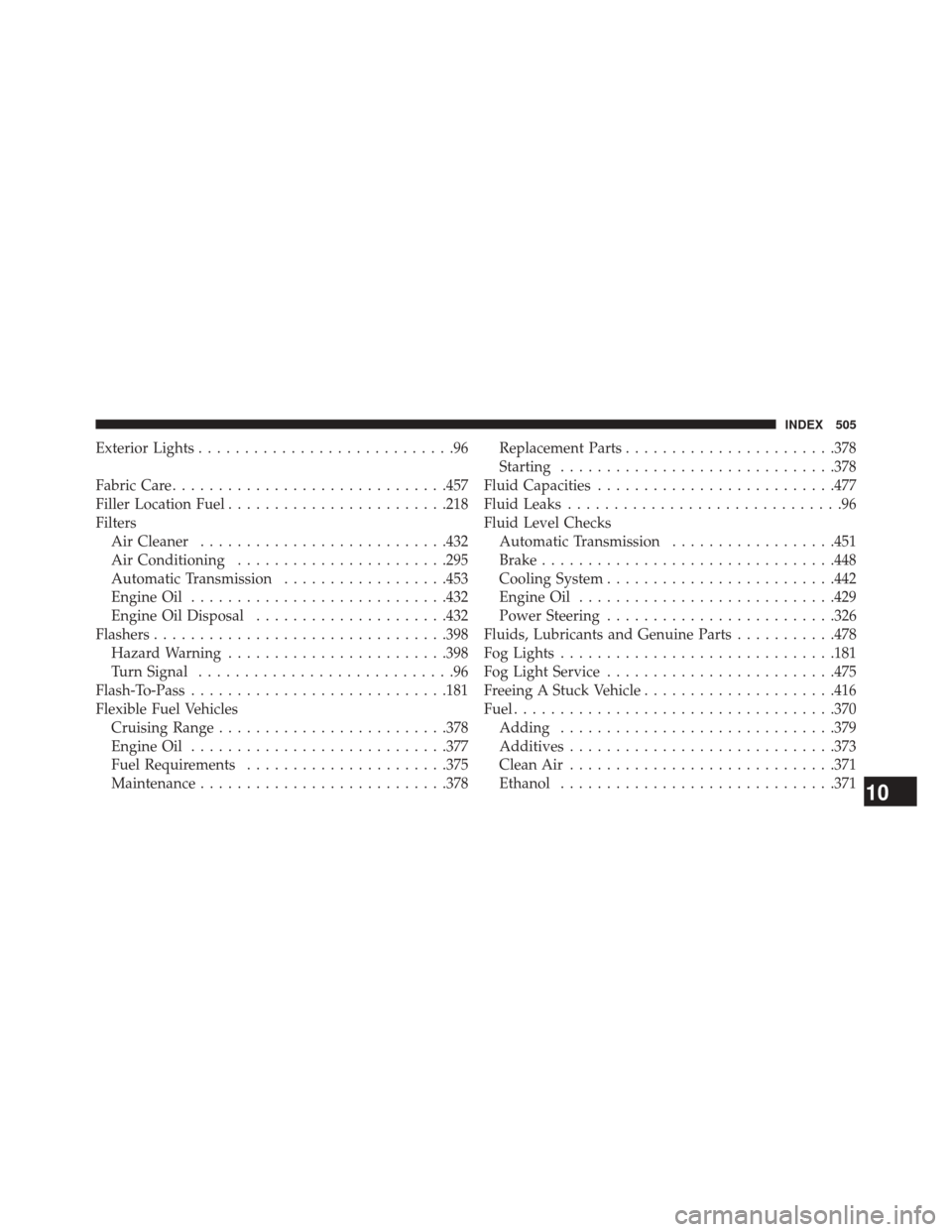
Exterior Lights............................96
Fabric Care ............................. .457
Filler Location Fuel ....................... .218
Filters Air Cleaner .......................... .432
Air Conditioning ...................... .295
Automatic Transmission ..................453
Engine Oil ........................... .432
Engine Oil Disposal .....................432
Flashers ............................... .398
Hazard Warning ....................... .398
Turn Signal ............................96
Flash-To-Pass ........................... .181
Flexible Fuel Vehicles Cruising Range ........................ .378
Engine Oil ........................... .377
Fuel Requirements ..................... .375
Maintenance .......................... .378Replacement Parts
...................... .378
Starting ............................. .378
Fluid Capacities ......................... .477
Fluid Leaks ..............................96
Fluid Level Checks Automatic Transmission ..................451
Brake ............................... .448
Cooling System ........................ .442
Engine Oil ........................... .429
Power Steering ........................ .326
Fluids, Lubricants and Genuine Parts ...........478
Fog Lights ............................. .181
Fog Light Service ........................ .475
Freeing A Stuck Vehicle .....................416
Fuel .................................. .370
Adding ............................. .379
Additives ............................ .373
Clean Air ............................ .371
Ethanol ............................. .371
10
INDEX 505